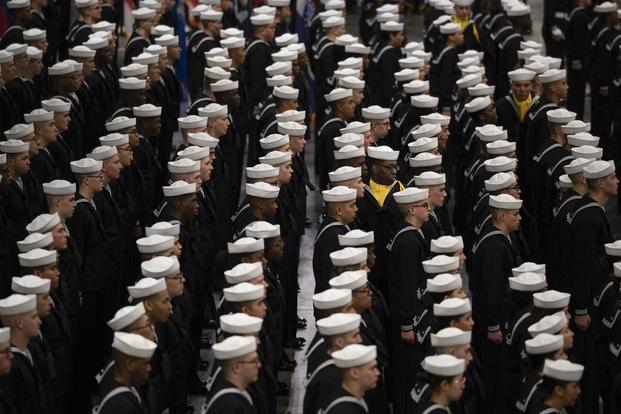The Navy, facing an increasingly tough recruiting environment, raised the maximum enlistment age by two years -- from 39 to 41 -- on Friday in an effort to allow more civilians to join its ranks.
"Effective immediately," recruiters will be able to enlist people who are as old as 41, provided that they don't hit their 42nd birthday by the time they report to boot camp, a copy of the new policy, provided to Military.com by the Navy, explained.
The policy also noted that some service communities like nuclear power, Navy SEALs and divers will continue to be able to set tougher restrictions for their members.
Read Next: They Said the Rise in Military Suicide Is a Mystery. Traumatic Brain Injury May Be an Answer.
Cmdr. Dave Benham, a spokesman for Navy Recruiting Command, explained that the change allows the service to "continue to navigate a challenging recruiting environment" and it hopes that, by raising the enlistment age, it will "widen the pool of potential recruits, creating opportunities for personnel who wish to serve, but were previously unable due to age."
Navy Times was the first outlet to report the new policy.
This change means the Navy is now willing to take the oldest recruits of any military branch. The next oldest are the Air Force and Space Force, which won't take recruits older than 39.
The challenging recruiting environment facing the Navy -- as well as all the other military branches -- is undeniable. According to the latest recruitment figures released in October, the sea service made its annual active-duty enlistment goal by just 42 sailors, recruiting a total of 33,442. It missed all of the other active-duty and reserve targets, including active-duty officers -- coming up just over 200 short.
At the time, the Navy's statement noted that "all branches of the military have struggled to make mission" and that it "implemented multiple initiatives" in order to accomplish its accession goal.
Rear Adm. Lex Walker, head of Navy Recruiting Command, warned in October that "the coming year promises to be even more challenging," adding that the Navy was "not starting the year in as strong a position as FY22."
The Navy's efforts this year included offering up what may have been its biggest cash incentive ever to enlist: $115,000 in possible bonuses and loan repayments. It followed that move by canceling early discharges and offering extensions to sailors already in the fleet.
However, those bonuses -- predicated on sailors being ready to ship immediately or with little wait -- solved a short-term problem but "came at a heavy price," Walker said.
By pushing recruits to immediately ship out, the Navy drained its pool of candidates who have signed contracts but are still waiting to head to boot camp. This pool is called the Delayed Entry Program (DEP), and it "allows the military flexibility in when they ship future service members to regulate the flow of future Sailors to boot camp and follow on training schools," the service explained last month.
Now, that reserve is at its lowest in 40 years, meaning most new recruits will need to start training immediately.
The short turnaround, aside from being a possible logistical challenge for would-be recruits, could be a problem for the Navy since that months-long wait was also a chance for recruits to try and get into shape to meet the branch's weight and fitness requirements.
Opening the doors to older recruits may get more people interested. But as outlets like Task & Purpose have previously reported, part of the issue with recruiting also stems from new medical screenings that are able to look at many more medical records than before. The result is a snarled, months-long process of setting up new appointments or searching for old paperwork. This situation is a challenge for teenage recruits, much less someone with as much as twice the lifetime of medical history.
Ultimately, this problem is not the Navy's alone to bear. The Army also missed its recruitment goals this year, while the Air Force was also forced to dip into its delayed entry pool to make its goals. The Marine Corps made its target figures but noted that it is preparing for a "challenging 2023."
-- Konstantin Toropin can be reached at konstantin.toropin@military.com. Follow him on Twitter @ktoropin.
Related: The Navy's Offering Up to $115,000 to Join or Come Back












